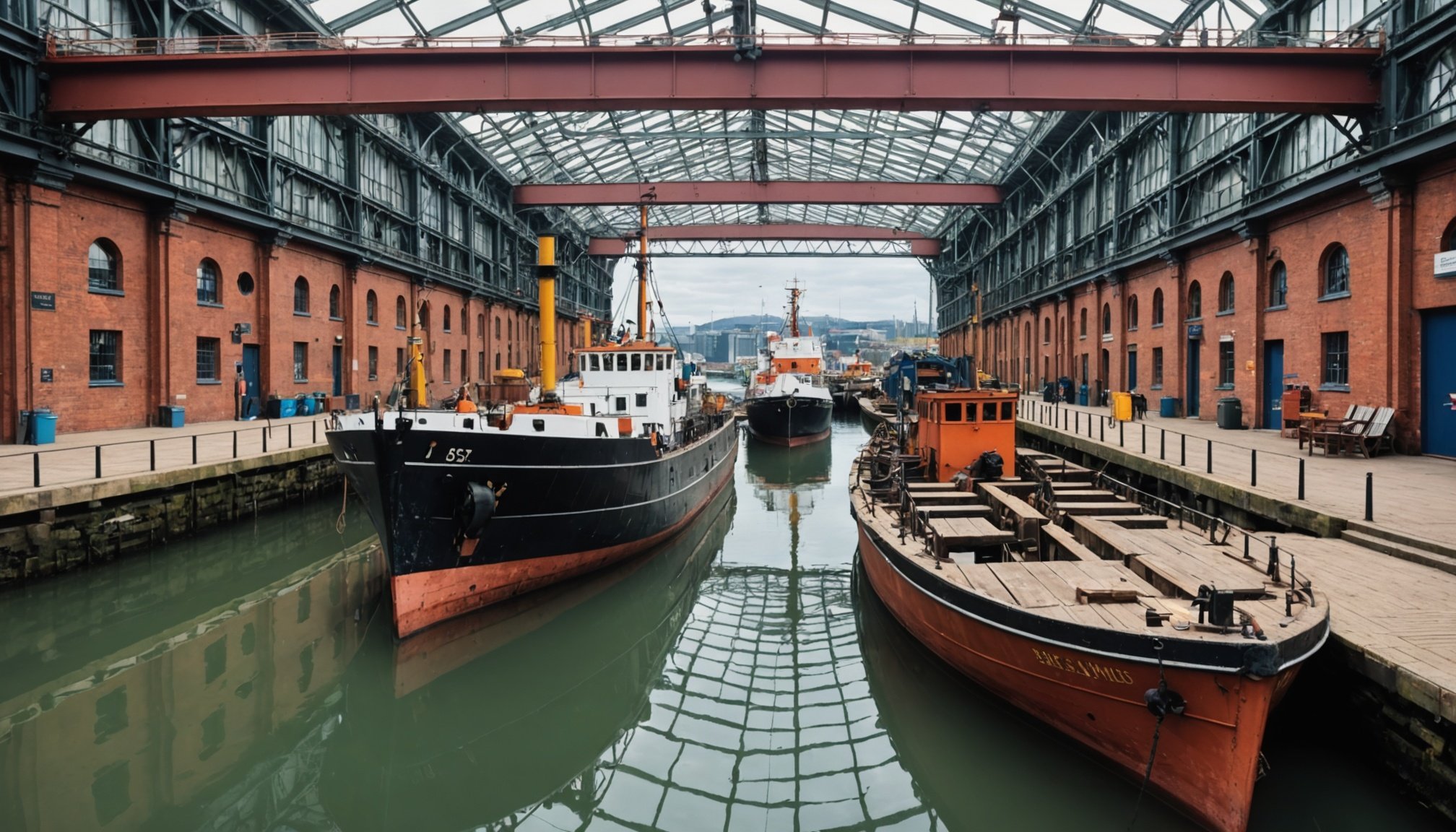Overview of Belfast’s Historic Shipyards
The Belfast shipyards stand as a testament to a profound maritime heritage, reflecting the city’s historical significance in the global maritime industry. As far back as the late 19th century, these shipyards have played a pivotal role in Belfast’s development, fuelling economic growth and making the city a key player on the world stage. Notably, Harland & Wolff, the most distinguished among the shipyards, laid the foundations for some of the era’s most iconic vessels, including the Titanic. This site, in particular, symbolizes Belfast’s legacy of shipbuilding excellence.
The importance of these shipyards extends beyond their economic contributions. They were arenas of technological advancement, pioneering various shipbuilding innovations that would set international standards. Features such as the gantry cranes introduced at Belfast’s shipyards became emblematic tools in maritime construction worldwide, supporting the assembly of enormous ocean liners.
Also to read : Top taxi services in ottignies: book your next ride now
Belfast’s shipyards are a beacon of historical significance—not just locally but internationally. They showcase the city’s capacity for innovation and enduring influence on maritime practices, leaving an indelible mark on both commerce and culture that continues to intrigue historians and visitors alike.
Engaging Narratives and Anecdotes
Dive into the captivating stories of Belfast’s historic shipyards, where maritime narratives are as rich and deep as the waters surrounding the city. The tales of hardworking shipbuilders and their contributions paint a vivid picture of the past. These shipbuilders were not just skilled craftsmen; they were artists in their own right, crafting vessels that would sail into legendary status. One such anecdote is the story of Thomas Andrews, the chief naval architect of the Titanic, whose dedication to ship safety and design is still spoken of with respect.
Also read : Your key to real estate in la tania: explore today!
Incorporating local legends into this industrial panorama adds another layer of fascination. You’ll hear about the so-called “phantom shipyard,” where ethereal voices of past workers are said to echo through the halls during quiet nights.
The local culture has been profoundly influenced by these maritime roots. Traditional songs, illustrating the life and times of shipbuilders, continue to be sung at local community events. These stories and legends not only provide insight into the technical prowess of Belfast’s shipyards but also into the human spirit that was inevitably entwined with its legacy.
Key Locations to Visit
Belfast’s shipyards offer a peek into bygone eras, with several notable shipyard sites that captivate both history buffs and casual visitors. Harland & Wolff stands as the crown jewel among historical landmarks, celebrated for its immense contributions to shipbuilding—not the least of which is the Titanic. Visitors can explore the iconic cranes, Samson and Goliath, towering symbols that narrate tales of nautical engineering. Another must-visit is the Titanic Belfast, a comprehensive museum experience detailing the illustrious story of the shipyard’s most famous creation.
Beyond Harland & Wolff, extinct shipyards like the Workman, Clark & Co. remain subjects of intrigue for those interested in the broader maritime heritage of the city.
For visitor attractions, the HMS Caroline, located in the Titanic Quarter, serves as a floating museum, offering rare insights into naval history.
Accessibility to these sites is well catered to, with organized tours and informative guides enriching the experience. Facilities at major locations include ample parking, guided tours, and interactive exhibits, ensuring each historical landmark truly comes alive for visitors stepping into Belfast’s shipbuilding past.
Expert Tips for Visiting
To enhance your experience at Belfast’s shipyards, timing is everything. Visiting tips suggest you arrive during weekdays, early in the morning or late afternoon, to avoid large crowds and enjoy a more intimate connection with local experiences. This quieter atmosphere allows you to delve deeply into the narratives surrounding these historical sites.
Consider embarking on guided tours offered by knowledgeable local historians. These tours bring the shipyard’s stories and achievements to life with expert insights. Local historians often share lesser-known anecdotes and can offer exclusive access to areas not typically open to the public. It’s a fantastic way to enrich your understanding of the shipyard’s impact on Belfast’s history.
For a comfortable visit, remember to pack essential items such as comfortable walking shoes, weather-appropriate clothing, and a camera to capture the rich maritime heritage. Don’t forget a small notebook for jotting down notes or reflections inspired by the visit.
Navigation guides available on-site will help you efficiently explore the area without missing key highlights. With thoughtful planning and the right guidance, your visit to Belfast’s shipyards can transcend a mere historical exploration, offering a window into the soul of the city.
Practical Visitor Information
Navigating Belfast’s shipyards is straightforward with essential visitor information readily available. Understanding the hours of operation is crucial for planning your trip. The shipyards typically welcome guests from early morning until late afternoon, but be mindful of seasonal variations. Checking the official timings in advance can save you from any disappointment.
Accessibility is designed for ease, accommodating individuals with disabilities. Visitors can expect ramps, elevators, and accessible restrooms at major sites. In terms of public transportation options, several buses and trains provide direct routes to the prominent shipyard locations. The Titanic Quarter is particularly well-served by both public and private transport services.
For those planning a visit, using the local transport networks is convenient. Many visitors opt for taxis or ride-sharing services for flexibility and ease. Additionally, local guides are available at main entry points to assist with maps and any other necessary visitor information. Remember, a well-prepared journey will allow for a more enriching exploration of Belfast’s historic maritime landmarks. Aligning your visit with available resources will ensure an engaging and accessible experience for every traveler.
Suggested Itineraries
Exploring the Belfast shipyards offers a splendid day trip, blending history and local culture. For a half-day journey, start at the iconic Harland & Wolff, a historical landmark synonymous with legendary ships like the Titanic. Here, engage with interactive exhibits that highlight significant maritime narratives.
Post-visit, enjoy a breezy walk to the Titanic Belfast museum housed nearby. This stop offers an in-depth dive into the social and industrial history of its notable shipyard sites. Allocate at least two hours to fully immerse yourself in this visitor attraction, featuring multimedia displays and reconstructions.
From there, consider combining your shipyard exploration with the vibrant Titanic Quarter, which is a stone’s throw away. This area boasts diverse dining options and cultural sites, offering a wholesome look into Belfast’s maritime heritage.
To maximize your limited time frame, assume an early start and, if possible, pre-book tickets, which helps bypass queues. Pack lightly and bring essentials suitable for unpredictable weather. Conclude your visit by capturing a panoramic view of the grand shipyard sites, leaving you with a deeper appreciation of Belfast’s historical significance.
Additional Resources and Local Tours
Exploring Belfast’s shipbuilding history through guided tours offers both educational insight and engaging stories. For those keen on immersive experiences, consider the top local tour operators who provide unique vantage points on the city’s maritime narratives. Their expertise offers enriched storytelling and insider knowledge.
-
Walking tours are a popular choice, enabling visitors to delve into the intricate details of shipyard operations, led by seasoned guides familiar with Belfast’s maritime legacy.
-
For a deeper understanding, immerse yourself in educational resources provided at local museums. These include detailed exhibits, photographs, and archives depicting the evolution of shipbuilding techniques.
-
Community events and exhibitions frequently celebrate this maritime heritage. Events often feature local crafts, ship models, and narratives, reflecting on the socio-economic impact of the shipyards.
Keep an eye out for workshops or talks hosted by reputable historians. These engagements not only bolster knowledge but also foster a community connection to Belfast’s shipyards. By participating, visitors gain invaluable insights and leave with a profound appreciation of the city’s shipbuilding prowess. This fusion of education and exploration ensures a memorable encounter with Belfast’s storied past.







